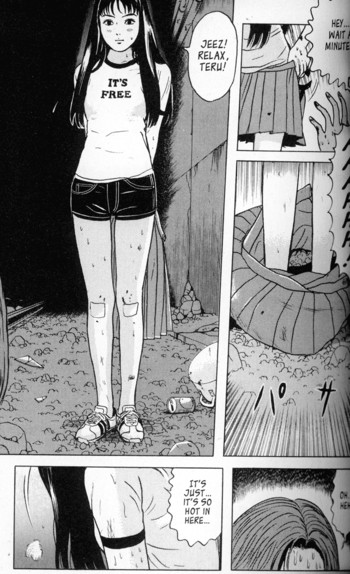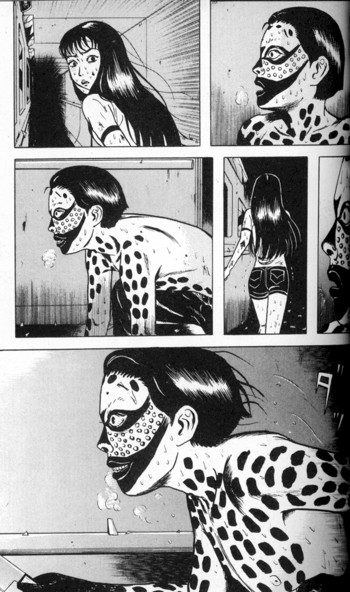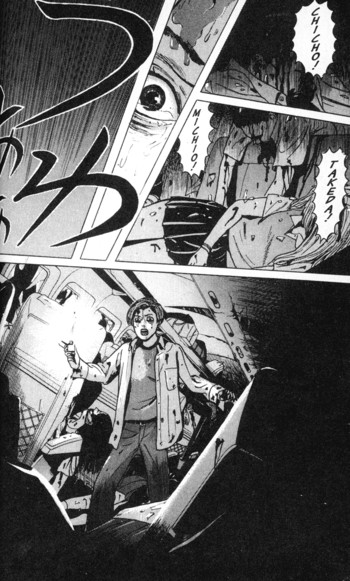Jason Thompson's House of 1000 Manga - Dragon Head
by Jason Thompson,
Episode CVII: Dragon Head

You wake in the dark. You are trapped between two heavy objects, and the floor is covered with broken glass. Your forehead is soaked in blood. Where are you? What happened? The last thing you remember, you were on a school trip, with all of your classmates, on the long train ride home. Then you remember: the earthquake. Everything shaking just as the train entered a tunnel, the train flying off the rails, your classmates' screams.
You call out for help, but no one answers. You crawl out from between the seats, wipe the blood from your face, and dig around in the handbags and purses on the floor until you find a lighter. In the dim flame you see what you suspected: corpses. Everyone but you is dead. You are trapped in the crashed train, in the tunnel, which has caved in on both sides. All around you is one darkness and dead bodies. Will rescuers find you and save you? How long can you survive? And ominously, the temperature is rising, as if you are buried in an earth oven, and the aftershocks of the earthquake are growing stronger, as if there is worse to come…
Dragon Head, by Minetarō Mochizuki, is one of the few manga where I've bought the entire run, in Japanese, the very first day that I saw it. Even before the whole series was translated by Tokyopop, before I even started seriously studying Japanese, I bought it just to look at Mochizuki's art. You can follow most of the plot even when it's untranslated; this is a simple story and the storytelling is very decompressed and cinematic, and if a Western comic artist could have told it in one volume with tons of exposition instead of 10 volumes without exposition, who cares? The slow pace, the moment-by-moment exploration of the situation, makes it an experience, not a story. It's part disaster manga, part horror manga: it's so suspenseful and immediate that you can really imagine being trapped in this nightmare. It starts with that great, first-person opening sequence: you wake in the dark…
It's not all done in first-person, though (although that would have been a cool manga, like the 1947 suspense movie Dark Passage in which the first half-hour is shot from first-person POV, decades before everyone was doing it in visual novels). The main character is Teru, a boy. He soon discovers that he is not the only survivor in the subway car: two other students have also survived. One is Ako, a girl who is nice but prone to collapsing. (Sadly, Ako is not the world's strongest female character; although there's not much fanservice in this manga, I suspect it's not by accident that Mochizuki dressed her in a tight breast-hugging shirt with IT'S FREE on it in big English letters.) The other is Nobuo, a shrill, paranoid boy who doesn't trust anyone. You know you're headed for Lord of the Flies survivors-fighting-one-another territory even before we see Nobuo's face: the first thing we see of him is his flashlight, shined right in Teru's face, as Nobuo yells "This is MY flashlight! I found it! SO IT'S MINE!" The three of them go to the cafeteria car and find food and water and wait to be rescued. Ako was injured in the crash, and Teru dresses her wounds. But no one comes for them, and the tunnel keeps getting hotter and hotter, and they get more and more scared. Claustrophobia takes hold, and Nobuo is the first to crack. When the rising heat forces them to take off their clothes, he covers himself with body paint and threatens the others with a butcher knife. He starts to rant and rave. "There's something down here…someone besides us! I'm talking about the creature that rules the darkness! We need a sacrifice! One that will satisfy him!"

Things go from bad to worse, and by sheer luck, in the nick of time, Teru and Ako escape from the collapsing tunnel. But that's only Volumes 1-2; their ordeal has only begun. After wading for hours through sewer tunnels filled with poisonous, steaming water, they emerge in an abandoned water treatment plant. The plant is in ruins, presumably from the earthquake, but as they look out the windows, they have an even greater shock. "It should be noon right now…why is it so dark? Is that the moon…?" To their horror they realize: what they thought was the moon is the sun. The skies are covered with thick clouds of smoke. A TV manages to pick up an emergency broadcast signal and a few moments of footage: something horrible has happened in Japan. Tokyo is in ruins. Everyone is gone. Even the looters and murderers seem to have fled. Teru and Ako must survive in an apocalyptic, ash-covered world, not knowing what has happened, not knowing where to go, not knowing if they'll ever see another human being…
And so begins the remaining 8 volumes of Dragon Head, a postapocalyptic adventure-horror story a bit like Cormac McCarthy's The Road. For someone who doesn't specialize in horror (his other manga range from funky adventures to romantic sports comedies), Mochizuki does a good job of making this manga so powerfully scary and creepy. A couple of things suggest the influence of Kazuo Umezu's The Drifting Classroom: the image of kids searching for food and water in a smog-choked, mud-covered wasteland, for one, and also the earthquake scene in the first chapter, which is handled almost exactly like in Umezu's manga. The slow, creeping pace is also very Umezu-like, and so is the heavy use of darkness, although Mochizuki is a much better draftsman than Umezu. Mochizuki's character designs are simple and iconic, but heavily shadowed, a little like Charles Burns' Black Hole. In contrast to the characters, the backgrounds are super-realistic: rubble and wreckage everywhere as if he looked at Katsuhiro Ōtomo's Akira and thought "Mmmhh…not detailed enough." There are page after page of nothing but the heroes wandering through washed-out roads, demolished streets, leafless forests. The tiny cast of characters are dwarfed by their surroundings. Even when they do meet other people, you hardly even see them: Mochizuki tends to draw the other passing survivors as nothing but dehumanized silhouettes, as if they're just a part of the darkness. Even the corpses are covered with dirt and ash, stripping them of their faces. The heroes are all alone; even the dead are gone.

The few people they do meet, they wish they didn't. The manga's theme—we know this because the characters basically tell us this—is fear, but in practice, fear seems to lead to madness and jerkiness. The first survivors we meet are a bunch of teens who seem almost excited by the apocalypse, dancing around bonfires wearing gas masks, embracing the disaster like characters from the disaster novels of J.G. Ballard. Then, they run into some deserters, soldiers who fled in their helicopter, although even they don't know what caused the apocalypse. One of the soldiers tries to rape Ako, another one tries to kill Teru, and basically, the meet-cute is a failure. They manage to get into the helicopter and fly to the Izu Peninsula, where they meet one of the few sane characters, a woman who survived by lashing herself to a tree when the tsunami (caused by the earthquake) struck. (Like Chiyoko in Akira, the middle-aged woman is the toughest character.) The woman tends to Teru, who has been injured. But the inhabitants of the neighboring villages have gone mad because of the disaster and roam the forests in a murderous swarm, planning to kill everyone who survived, then kill themselves. Ako and one of the military men fight off the madmen, and then the small group of heroes heads to Tokyo, hoping against hope to find their families alive. Meanwhile, the natural (?) disaster just keeps going: tremors smash the remaining buildings, fire tornados sweep through the cities, floods turn everything to mud, clouds of ash smother the land. It's definitely all awesome to look at, real Roland Emmerich style. In Izu, a mysterious man with his head bisected with lobotomy scars whispers two words which might be a clue: "Dragon Head…" Somehow, Katsushika Hokusai's painting The Dragon of Smoke Escaping from Mt. Fuji might also be a clue to what has happened. Were nuclear bombs involved? Did a meteorite fell on Mt. Fuji, triggering an eruption? And what about the visions of a dark, demonic figure that Nobuo raved about, and which torment Teru's dreams as well? Is it all just a figment of madness, or is there something out there, something supernatural, behind the destruction of Japan?
Now is the point where I have to go into spoilers and tell you: none of these questions are actually answered in this manga. Dragon Head is a very, very well-done manga for the first two volumes, but then it sort of drifts off, as if the artist, like Teru and Ako, is wandering in a wasteland with no idea where to go, unable to see more than a few feet in front of his face. Reading Dragon Head is an interesting glimpse of how manga stories are structured so that they could end at certain points or get expanded if they're popular enough; the manga would've been short but sweet if it ended when Teru and Ako got out of the tunnel, but after they get out, it never follows through on its promises of a big revelation or a character arc to tie everything together. Dragon Head is like a painting where all the details are beautifully drawn, but the composition is sloppy.

Let's take the most obvious thing: the disaster. What the hell happened? Minetarō Mochizuki doesn't necessarily owe it to the audience to tell us why the world has been destroyed: in Michael Haneke's postapocalyptic movie The Time of the Wolf, we never find out exactly why the world has collapsed and people are fighting over food and shelter. But Haneke's movie is about how people behave when things go bad, not about why things went bad, and unlike Mochizuki, he doesn't rub the audience's face in it by continually teasing that he might explain it. In Dragon Head, Mt. Fuji has erupted, but there's obviously more to it than that. A huge volcanic eruption would certainly be major enough to make a good disaster manga: even a small volcanic eruption can send enough ash into the air to make it impossible to fly an airplane. A truly big volcano could cause worldwide chaos: the 1815 eruption of Mt. Tambora in Indonesia, the most powerful volcanic eruption in recorded history, blanketed the entire world in ash, causing strange snowfalls and low temperatures around the world, leading to what is called "the year without a summer." But there's obviously more to it than this. A few cryptic hints suggest that the energy of the earth itself has been released, not just as lava but some kind of planetary energy, like ley lines. The 2003 Japanese live-action movie adaptation added a little more explanation: the reason everybody is so nuts is because the tremendous underground cataclysm, which also caused the earthquakes and volcanoes, screwed up the planet's magnetic fields, driving everybody crazy. This explanation works for me, but it's not in the original manga. In the manga, even at the very end, Mochizuki doesn't explain anything, and even the soldiers from foreign countries who come to occupy Japan at the end (more shades of Akira) don't know what's going on. ("What's going on in this country? I don't know…we're waiting for more reports…") It feels like Mochizuki was hedging his bets: maybe the manga would turn supernatural? Or maybe not? For god's sake, Mochizuki: I've read 10 volumes, the manga is ending in just a few pages, you can only have a "mysterious disaster" manga for so long before YOU HAVE TO DECIDE WHAT THE DISASTER IS!!! The last-minute nuclear subplot doesn't make much sense either. Basically: if you're writing a story about some mysterious occurrence, the reader doesn't necessarily need to find out the whole truth, but I think it's important that you should feel like at least the author knows. I never got this feeling from Dragon Head.
Whew; I got a little carried away there. Like Nobuo, let me say "I'm sorry about my short temper…"; I just can't stand inconsistencies in disaster stories. But, there are still lots of good scenes in Dragon Head, even if it is a journey without a destination. It's a good thing it wasn't running during the 2011 Tôhoku earthquake, or its gruesome images of massive destruction might have been too raw; much tamer manga were canceled as a result, like how immediately after 9/11, all images of buildings collapsing were essentially banned from American movies and TV. This is a very well-made manga, even if the ending is lacking, and even if, IMHO, it has a manga-esque tendency for the characters to go into long emo monologues about "fear" and "hope" and the meaning of life which have no resemblance to anything that actual human beings would actually say in a real-life situation. Eventually, I started agreeing with Nimura, one of the military men: "You're obsessing over some psychological bullshit! Things are plenty bad without worrying about whatever bullshit is in your fucking head!" I'd like to read more of Mochizuki's manga. I'd like to know what's really in his head. And he can sure draw demolished buildings.
discuss this in the forum (12 posts) |
this article has been modified since it was originally posted; see change history